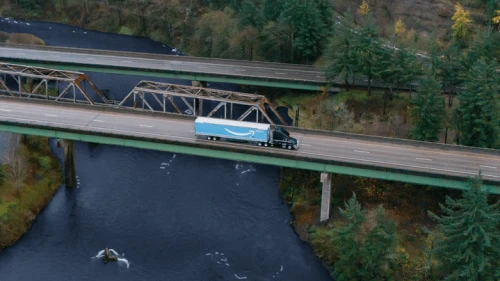
Catch up on our latest moves.
News updates
It’s been a busy spring for Amazon Freight. We’ve been on the road at the transportation industry’s biggest events and meeting with shippers. Here’s where the events season has taken us recently.
This year, for the FIRST Championship robotic competition, Amazon Freight donated the use of three of its trucks and trailers for high school teams to get their robots to and from Houston where the event was held.
As a shipper, your time is at a premium, and you need the easiest way to find and book loads. Our site is built for you.
Learn about Amazon Freight’s new inbound less-than-truckload (LTL) offering and how shippers can take advantage of the Amazon network.
No shipper wants to be wondering “where is my load?” more than they have to. When we asked shippers what the top tech solution they wanted from their freight provider was, the number one answer was advanced tracking and visibility tools. We have been listening and are now giving shippers even better insights into the status of their Amazon Freight shipments.
The start to 2025 in freight has had its dose of uncertainty, but at Amazon Freight we’re staying steady and continuing to tap our customers into the speed and reliability of the Amazon network. Here’s everything we’ve been up to and what we have planned for the spring.
Shipper tips
As we approach the end of 2025, it’s clear that this year has been a defining period for the shipping industry. The challenges that emerged have not only tested operational resilience but also accelerated innovation and strategic thinking.
Whatever you’re trying to transport, it’s always good to have options. But those options can get confusing to understand how they fit with your transportation needs. To help, we’ll bring clarity to some of Amazon’s top transportation offerings.
Breaking into the shipping world frequently means learning on the fly. That is exactly what happened to Adam Bartell when he joined Intelligent Blends as the operations manager six years ago. He has been learning ever since, so we asked him to tell us more about his experience.
Three years ago, Hanna joined JW Fulfillment as a project manager, and she has been learning ever since. We sat down with her to hear what she’s discovered along the way and what other 3PLs and shippers can learn.
The holiday season is just around the corner, and that probably means your orders are picking up. When that happens, the chance for mistakes increases. With that in mind, here are the top tips to help keep your shipments moving smoothly for your customers.
For successful shippers, the little things are big things. Our research shows that Differentiators—those that optimize shipping to gain a strategic advantage—see shipping as something much more than just moving freight.
Customer stories
If you work in logistics at a company that sells water bottles, there’s no humor when your operations experience a “bottleneck.” Such backups send kinks throughout the supply chain. That’s what Joel McAllister of
HydroJug faced on a weekly basis before they started using Amazon Freight.
When you work in the world of logistics, some days are filled with chaos and uncertainty. Hanna Xu is familiar with those type of days as a project manager for JW Fulfillment. With Amazon Freight, she’s found a provider that is a sense of calm in the storm.
When people want their coffee, they usually want it now. That’s the challenge Intelligent Blends faces each week. That means their freight provider has to be on point, says Adam Bartell, their manager of operations.
Bryan Cuevas, CEO of C Group Logistics, knows the feeling of watching a trailer leave his yard. “You need confidence it’s going to get where it needs to be.”
Before turning to Amazon Freight, Calgary-based Specialty Laminates had a major barrier, and that was freight.
“Where is my trailer?” That’s the question no shipper likes to ask, but Savie Yuan found himself posing it more often than he liked.


















